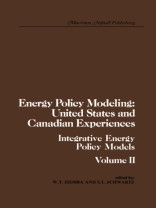Alex Cowie As the twentieth century draws to a close, one of our greatest problems is the availability of energy. One way to study the energy problem is to resolve it into four areas: energy demand, energy sources, transportation of energy from sources to demand centers, and the optimal allocation of energy forms to demands. Each of these areas is extremely complex by itself. When efforts are made to tie them together, for example, to produce a National Policy, the complexities are compounded. Another way to study the energy problem, because of its political and social consequences, is to resolve it into geographical areas. Individual provinces of Canada or states of the United States will have their concerns about energy within their geographical boundaries. As producer, consumer, or both, each wants to ensure an energy development program which will work to the maximum benefit of its citizens. Similarly, countries endeavor to protect their citizens and undertake energy policies that will assure either a continuation of the existing quality of life or – particularly in the case of "Third World" countries – a marked improvement in quality of life. These competing and conflicting goals call for a study which encompasses the whole world. Again, complexity is piled upon complexity. If the prob- lem is not yet sufficiently complex, there is an equally complex question of the effect of energy production and use on the ecology.
S.L. Schwartz & W.T. Ziemba
Energy Policy Modeling: United States and Canadian Experiences [PDF ebook]
Volume II Integrative Energy Policy Models
Energy Policy Modeling: United States and Canadian Experiences [PDF ebook]
Volume II Integrative Energy Policy Models
Bu e-kitabı satın alın ve 1 tane daha ÜCRETSİZ kazanın!
Dil İngilizce ● Biçim PDF ● ISBN 9789400987517 ● Editör S.L. Schwartz & W.T. Ziemba ● Yayımcı Springer Netherlands ● Yayınlanan 2012 ● İndirilebilir 3 kez ● Döviz EUR ● Kimlik 4704396 ● Kopya koruma Adobe DRM
DRM özellikli bir e-kitap okuyucu gerektirir












